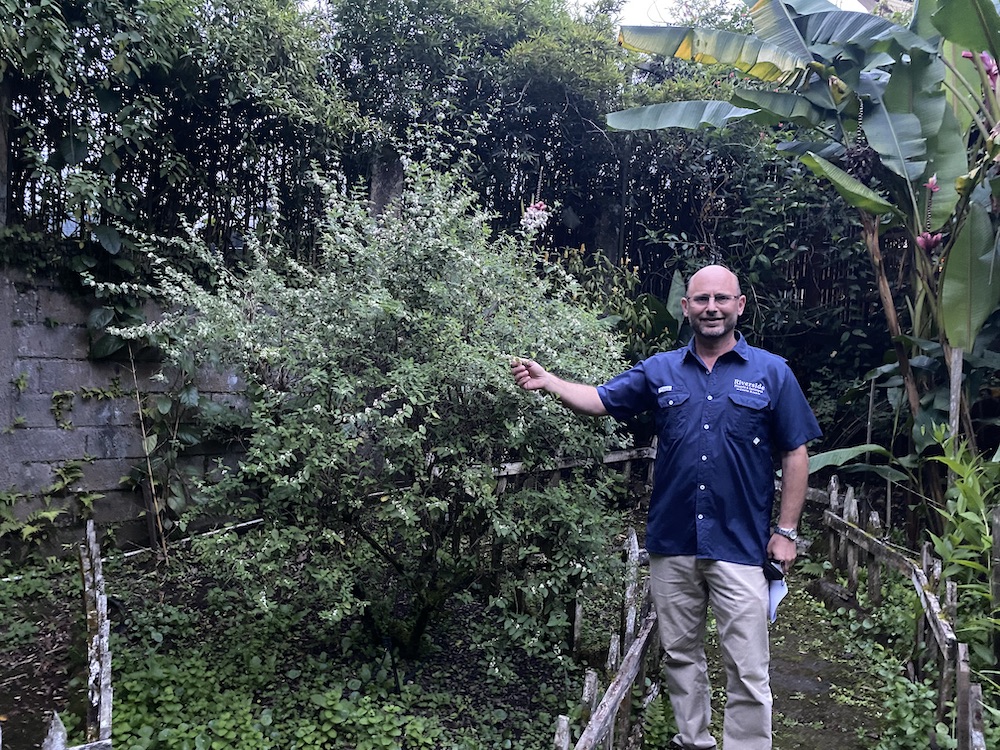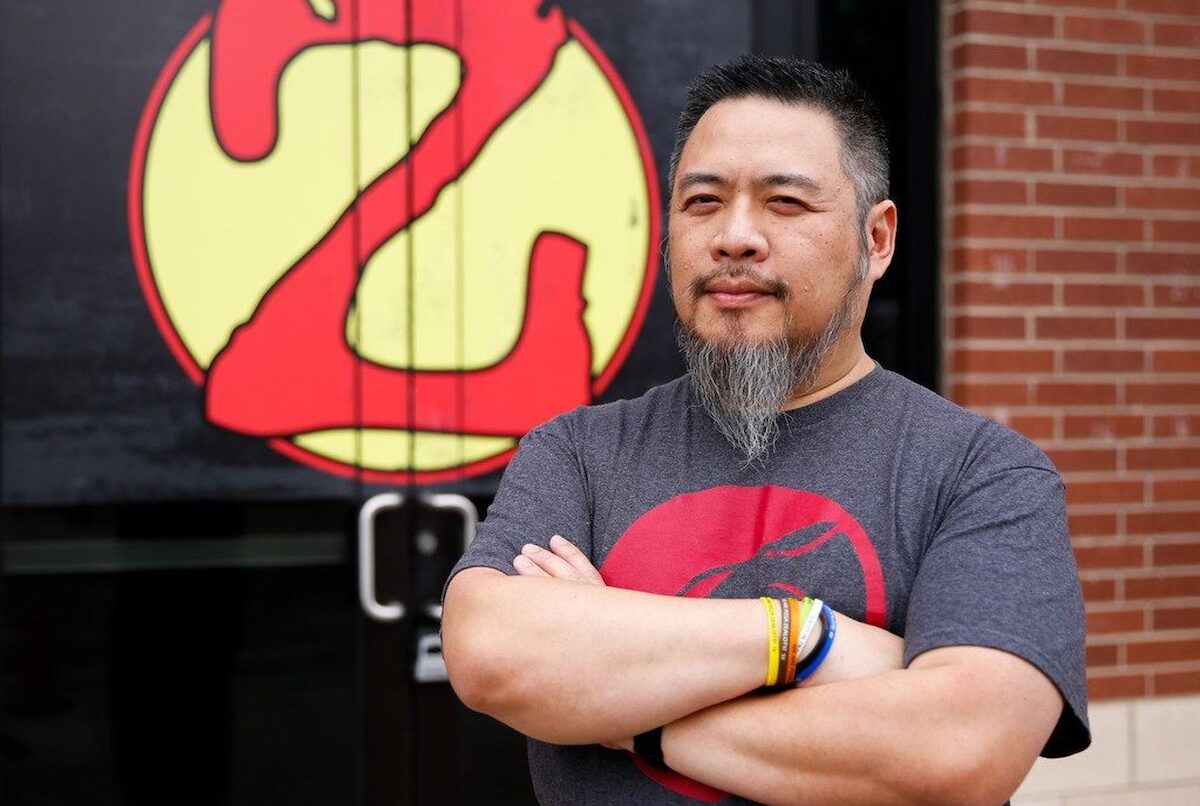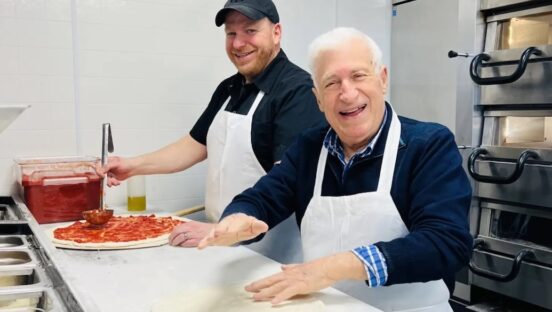- Inspired by a 1987 trip to Italy, Daniel Harris has created a sustainable, triple-bottom-line restaurant that delivers profits while supporting the environment and the community.
- Riverside Pizzeria & Gastropub constructed all of its furniture with repurposed wood and uses composting to bolster the soil and create tastier produce in Harris’ own garden.
Related: Survey finds Americans are increasingly concerned about food and sustainability
Story and photos by Rudy Waldner
Daniel Harris, owner of Riverside Pizzeria & Gastropub in Heredia, Costa Rica, commits to tastefully concocted offerings by using truly garden-fresh ingredients from the restaurant’s meticulously manicured yard, combined with local culinary magic and a fierce dedication to the environment and his team. It’s quite the selfless approach to business and Mother Nature that’s obviously been working extraordinarily well. Daniel seems to get it all right, and then some.
During our meal and wine tasting, one thing that became glowingly apparent was that if Harris didn’t know something, he picked up a book or two and researched the topic—all to great success. Let’s start with the heart of a pizza restaurant: the oven. Harris was looking for something that didn’t seem to be available from traditional suppliers, so he read “The Bread Builders: Hearth Loaves and Masonry Ovens.” He found what he wanted, but he couldn’t find a mason to execute the build-out. He finally partnered with a brick layer and they built the oven together. The oven has walls that are two feet thick, conveying and storing high heat so pizzas are conveniently baked in 90 seconds. The oven stays heated overnight as the thick walls store the energy, so much so, that in the morning using only the captured heat from the previous evening’s wood, he bakes bread, muffins and quiche (baked in depreciating order of temperature demands). No additional fuel needed!

While we’re exploring fuel, Riverside uses coffee wood to fire its oven. The restaurant is located in a coffee-producing region. Coffee plantations require renovation and replacement of old plants. The old growth is a byproduct, which is some of the best wood possible for cooking. Harris gets his wood from the surrounding area coffee plantations, which gives his pizza and baked goods an extra layer of flavor.
In addition to the byproduct use of coffee wood for the oven, all of Daniel’s furniture is built from repurposed wood (wood that has been salvaged from old structures). Plantation teak is used for the complex’s construction. I’ve googled “plantation teak” so that you don’t have to: Plantation wood is usually grown on government farms so as not to disrupt existing forests, especially as natural teak is becoming endangered.

Coffee wood is used to fire the oven at Riverside Pizzeria.
A study of commercial and residential buildings in four U.S. cities revealed the potential for large carbon-impact reduction by comparing the relative environmental impacts of building reuse and renovation versus new construction over an assumed 75-year lifetime. Contrary to popular belief, the benefits of reusing and renovating buildings outweighed the benefits of constructing new energy-efficient structures. According to the study, a new building that is 30% more efficient than the average building takes 10 to 80 years to overcome the negative climate-change impacts resulting from construction. Well, Harris did just that—he retrofitted/refurbished an old abandoned building that used to be a discotheque/restaurant that burned down and was left to rot 30+ years ago. The cement walls add personality as well as zeitgeist to the space.
Everybody is aware of composting and its benefits for the ecosystem, plants and the environment. Very few people know about the four phases and the technical details of the stages involved in composting. Suffice it to say, it ain’t easy. Riverside Pizza composts religiously and thoroughly. One of the best benefits of this practice is that super-fertile soil grows robust vegetables and herbs, raising the flavors in the restaurant to exquisite. No exaggeration here!

Composting produces super-fertile soil for tastier produce.
And finally on to the best part: the food. It’s either grown in the backyard or with locally sourced components, cooked with coffee wood in a historically influenced, efficient oven and served with a smile, all adding up to a magnificent meal. Add in a local twist on some of the classics, and you should begin salivating right about now. For example, Riverside’s Margherita pizza includes the word “style” on the menu for a reason. Rather than importing the “real thing” from Italy, the team grows its own tomatoes and blisters them in the oven to remove the skins and create a delectable red sauce. Another example: Rather than just using chickpeas in the hummus, the kitchen blends in a local vegetable, pejibaye. Que bueno!

The Margherita-style pizza
Related: Why restaurant packaging is more important than ever
The meal and sampling was an extraordinary experience. I’ve already booked a return trip for February. Meanwhile, I sat down with Harris to ask him some more questions for PMQ’s readers:
Waldner: Tell us a little history about your pizzeria.
Harris: I purchased the property in an estate sale. It was the burned-out remains of a restaurant and disco complex that was overgrown and deteriorated from a fire, then 25 years of being abandoned. My work in sustainable real estate development was going pretty slowly after the 2008 market crash and in 2012, I decided to work on creating a sustainable project of my own on this property.
From the outset, I knew I wanted it to be a project that not only would be successful as a restaurant but also would be a model for doing business in a more sustainable way. We employ the “triple bottom line” approach, which means our decisions take into account not only our financial bottom line, but also the impact of the decision on the environment and the community.
We provide work opportunities to local residents and teach them to become professionals with the highest standards of excellence. We grow organic greens and herbs in our garden. We produce organic fertilizer with all the food waste from the restaurant. These are a few examples of how we work within our value structure. We are now six years old and going strong. We just signed a contract to produce most of our electricity with solar panels that will be installed on the roof of the restaurant. We are continuously innovating both in the kitchen and in the business.

Rudy Waldner (left) visits Daniel Harris in the latter’s distillery.
Waldner: What makes your pizza unique?
Harris: We produce pretty traditional Neapolitan-style pizza in a wood-burning brick oven, but we use fresh local ingredients in innovative ways. We make our tomato sauce from scratch, using locally grown tomatoes that get fire roasted in the oven before making the sauce. We source many ingredients from our gardens and others from small local producers. So we have some pretty traditional pizzas, such as Margherita, pepperoni, prosciutto, etc., but we also have some unique pizzas that use local ingredients like goat cheese, heart of palm, plantains, etc.
We also make our own craft beer, rustic brick-oven pastries, and other innovative dishes from the brick oven. Our value proposition is consistent high-quality pizzas using fresh ingredients at affordable prices. We offer our clients an experience that goes beyond the food and beverages they consume at Riverside. They can also enjoy live jazz of the highest quality, art exhibitions that change every few months and other attractions, such as a visit to our organic gardens or a guided tour of our micro-brewery.
Waldner: Who is your typical customer?
Harris: The location and choice of concept has allowed us to appeal to a wide segment of the population. We do not intend to be an exclusive restaurant; to the contrary, we strive to be inclusive. Our clients are local families, young adults on dates, foodies and foreigners on their way to the Caribbean Coast. Also, people who have heard good things about us and travel from other parts of the central valley to visit.
Waldner: How do you market your business to new and existing customers?
Harris: We have been successful largely through word of mouth. Since the day we opened, we have been overwhelmed with demand. We use Facebook and Instagram to market and announce activities and changes, to announce new products, musical and artistic programming and to educate our followers regarding how we do things at Riverside. We have over 30,000 followers and we find it a very effective way to communicate with them.
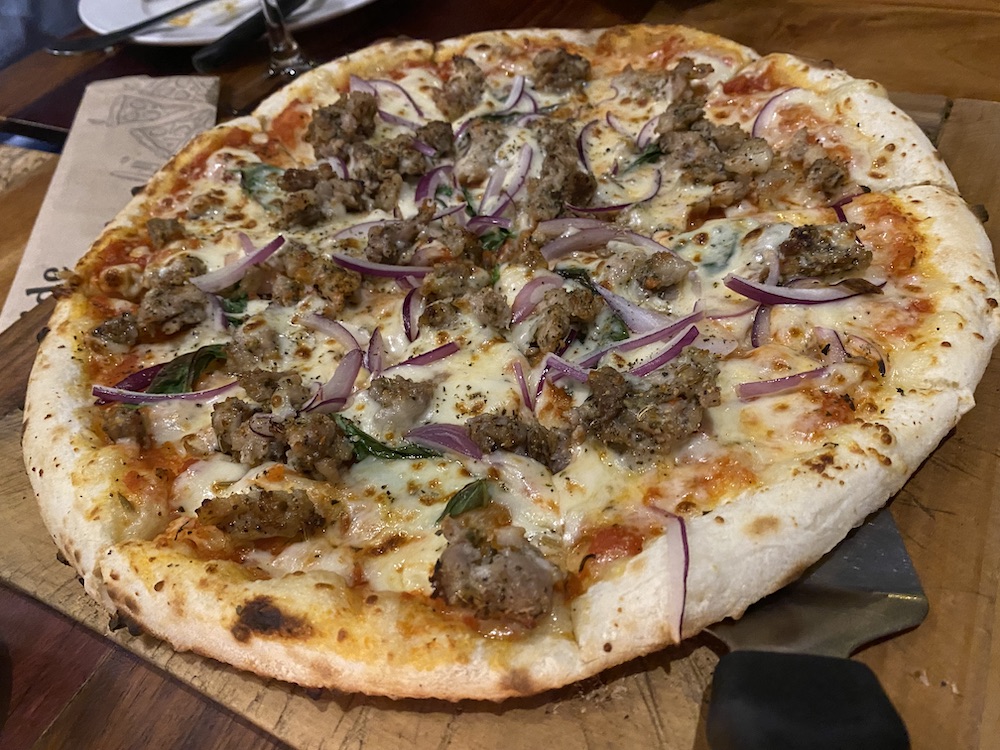
Waldner: What are your most popular menu items?
Harris: Our pizzas are the most popular menu items. All of our pizzas sell well. We sell a good mix of traditional pizzas and more innovative combinations using local ingredients such as the Pizza Guapileña, which has heart of palm, goat cheese and pejivaye, an indigenous palm fruit. Our No. 1 seller is our homemade Italian sausage pizza.
Waldner: What has been your biggest challenge?
Harris: Staffing. We always try to hire and train local residents from the town of San Isidro. Many of them have never worked in the F&B industry before, so it takes quite a bit of time and effort to determine where they will be most effective in the organization and if they really have a passion for the industry. With that said, when we do figure it out, we end up with extremely loyal and passionate workers that give Riverside the warm and friendly feel that our customers identify as soon as they walk in the door.
Waldner: How do you compete with surrounding pizzerias?
Harris: We offer a superior product. We put passion and love into every step of the process and every ingredient. We also have a very strong training program and a relentless effort to continuously improve customer service. So we offer a superior product, with great service with the added attraction of music, art and artisanal onsite production, all for a very competitive price.
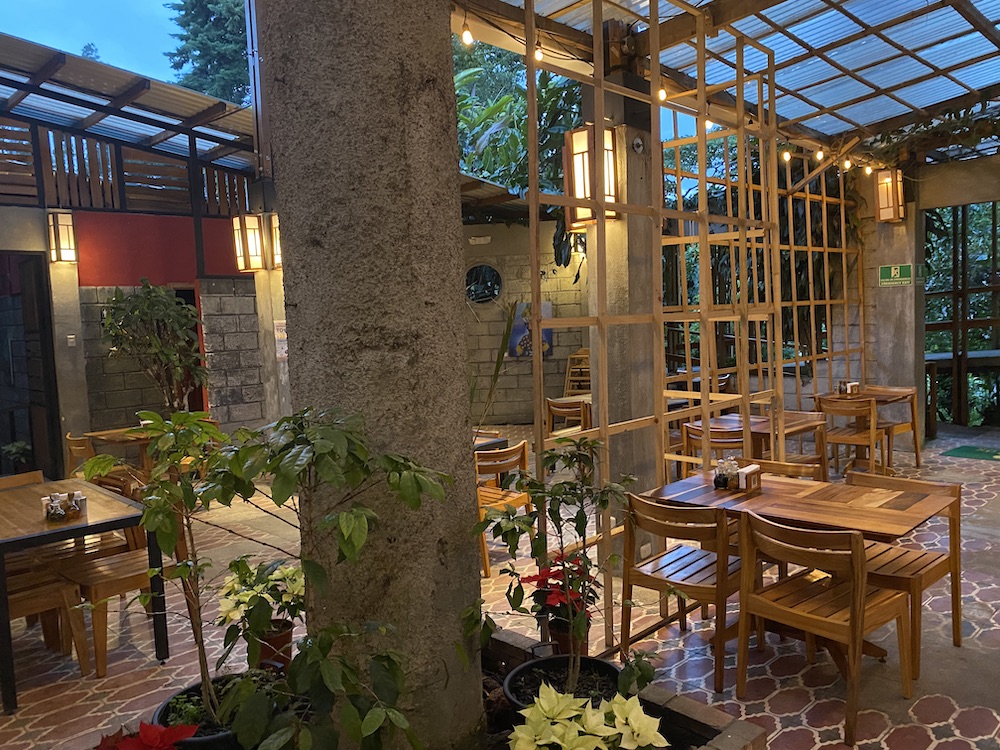
Riverside offers delicious food amidst the scenic beauty of Costa Rica.
Waldner: How do you get involved in your community?
Harris: For Riverside, Community involvement has been a priority from day one. We work with a local public nursing home facility, and our employees volunteer to assist with activities there. Next week we will be offering them a holiday dinner served by our employees with live Christmas jazz, and we will give each of the residents a small gift from our staff members.
We also work together with a local Animal Rescue Center. One of our ways of supporting them is to do an annual fundraiser at Riverside. The proceeds from the event help to fund animal shelters and other needed resources at the center. And we work together with the local community center, supporting efforts such as entrepreneurial fairs and other activities for the local community.
Waldner: Do you currently offer online ordering and/or a loyalty program?
Harris: No. We have delivery service, which we provide using our own employees. We do not use any third-party services such as Uber Eats. Ordering is done by phone or WhatsApp, not online. We do not have a loyalty program per se, but we do have a list of our order-out customers and we contact them with new products and news.
Waldner: What’s been your biggest accomplishment?
Harris: Providing rewarding work and growth opportunities to 30 loyal employees throughout very difficult times during the past two years of restrictions and other challenges.

Waldner: What’s your favorite pizza?
Harris: The one that just came out of the oven. They’re like my kids … I love them all.
Waldner: What do you do when you’re not making pizza?
Harris: I like to hike in the mountains, ride my motorcycle in remote areas of the country, play tennis, spend time with my 17-year-old son and visit other restaurants and music venues.
Waldner: What will your next business be?
Harris: On-site coffee roasting, on-site chocolate production and a second restaurant.
Waldner: How has Italy’s food scene influenced you and your restaurant?
Harris: When I visited Italy in 1987, I tried every pizza I could. I realized that what I knew about pizza was very limited. There was so much more to pizza, and when it is done well, it can be so simple but so good. When I saw the beautiful wood-burning ovens used to make bread and pizza in Europe and tasted the delicious products fresh from the oven, I was hooked.
Rudy Waldner is a world traveler, consultant, author, journalist and educator who frequently judges U.S. Pizza Team competitions and other culinary contests around the globe. Learn more about him at rudywaldner.com.



